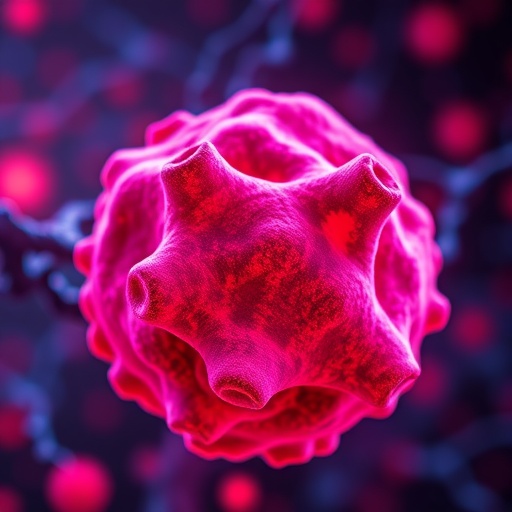
In an unprecedented medical development, researchers have reported a total reversal of pulmonary circulation induced by peripheral cannulation for veno-arterial extracorporeal membrane oxygenation (ECMO) in a complex case of a patient grappling with significant aortic and mitral valve insufficiency. This innovative approach, documented by Heymer, Bent, and Raepple, represents a significant advance in critical care, highlighting the potential for life-saving interventions in patients facing dire cardiovascular challenges.
Historically, the management of severe cardiac conditions has posed considerable difficulties, particularly when traditional surgical options are not viable. In such scenarios, ECMO has emerged as a pivotal tool, providing temporary support for patients whose lungs or hearts are unable to maintain adequate circulation and oxygenation. However, the methodology behind its implementation continues to evolve, as demonstrated in this recent case study, which pushes the boundaries of conventional ECMO applications.
The patient at the center of this study exhibited critical cardiovascular issues stemming from both aortic and mitral valve insufficiency, conditions that can drastically affect blood flow dynamics and overall cardiac function. Traditional treatments may have included valve replacement or repair surgeries. Yet, due to the complexities involved, the decision was made to utilize veno-arterial ECMO through peripheral cannulation, a method that has garnered attention for its potential benefits in terms of reduced recovery time and lower risk of complications. This technique allows for blood to be withdrawn from the venous system, oxygenated externally, and then returned to the arterial system, thus mechanically supporting circulation.
What sets this case apart is the unprecedented phenomenon of total reversal pulmonary circulation, a rare occurrence that generally is not expected to happen during standard ECMO treatment. The patient’s transition into this state serves as a critical reminder of the body’s complex physiology, particularly when external mechanical support systems like ECMO are introduced. The implications of this reversal are vast, urging a reevaluation of how medical professionals might maneuver in similarly complex situations involving severe cardiac dysfunctions.
The authors meticulously documented the physiological changes observed in the patient during the ECMO treatment. The reversal of pulmonary circulation presented unique challenges, as it indicates that the typical route of blood flow from the right heart to the lungs was fundamentally altered. This altered status can significantly impact the delivery of oxygen and the removal of carbon dioxide. Medical teams involved had to employ vigilant monitoring strategies to ensure that systemic oxygenation remained adequate even in this unconventional state—confirming the need for continuous adaptation and responsiveness in acute care settings.
As the case unfolded, the research team carried out a comprehensive analysis of the hemodynamic parameters observed during treatment. By employing advanced imaging modalities and hemodynamic monitoring technologies, they were able to track the patient’s progress and respond dynamically to real-time changes. This level of detailed clinical oversight exemplifies the intense scrutiny required when managing patients undergoing complex ECMO strategies, especially when encountering unexpected physiological shifts.
Another crucial aspect of their findings relates to patient selection and potential prognostic factors. The authors emphasize that not all patients with significant valve insufficiencies are suitable candidates for peripheral ECMO. In fact, careful consideration must be given to the underlying causes of cardiac failure, existing comorbid conditions, and the patients’ overall organ function to predict outcomes accurately. This complexity necessitates an interdisciplinary approach to patient care, involving cardiologists, intensivists, and perfusionists working closely to formulate the most appropriate treatment plan.
Furthermore, post-treatment analysis raised questions about the longer-term impact of such interventions, particularly concerning vascular integrity and recovery of natural pulmonary function. It is critical in future studies to assess not only the immediate benefits of ECMO-related techniques but also the potential long-term consequences for patients who experience such drastic changes in hemodynamic status. Continuous research is essential to elucidate how best to manage the evolving field of mechanically-assisted circulatory support.
As the medical community digests these findings, it opens up discussions regarding the ethical implications and the necessary training for healthcare professionals involved in cutting-edge technologies such as ECMO. Comprehensive training programs and guidelines will need to be developed to prepare clinicians for the challenges posed by complex scenarios, particularly those that do not follow standard protocols. There lies an important responsibility to ensure that healthcare teams are well-equipped to respond thoughtfully to unexpected complications.
This case report prompts further inquiry into the nuances of mechanical circulatory support and highlights the emerging paradigm shifts in treatment methodologies. Healthcare professionals must approach these advancements with a prudent mindset, balancing innovative practices with the foundational principles of patient safety and effective care. As knowledge expands in this field, so too must the frameworks within which these technologies are utilized.
In conclusion, the documented case of total reversal of pulmonary circulation induced by ECMO opens new avenues for future research in cardiac care. The findings not only inspire awe but also demand rigorous exploration into the physiological implications of such interventions. As we venture further into uncharted territories of medical innovation, it is imperative to maintain an ongoing dialogue surrounding best practices, patient selection criteria, and long-term impacts. The advancements in ECMO technology provide a glimpse into a future where complex cardiac conditions can be managed with increasing efficacy, ultimately leading to better patient outcomes.
As researchers and clinicians reflect on the implications of this study, it is clear that this unprecedented approach is only the beginning. Continued investigation will refine understanding and practice in this pivotal area of medicine, aiming to transform the way critical cardiac conditions are treated in the years to come.
Subject of Research: Total reversal of pulmonary circulation induced by veno-arterial ECMO.
Article Title: Total reversal of the pulmonary circulation (RPC) induced by peripheral cannulation for veno-arterial ECMO in a patient with aortic and mitral valve insufficiency: a case report.
Article References:
Heymer, J., Bent, D. & Raepple, D. Total reversal of the pulmonary circulation (RPC) induced by peripheral cannulation for veno-arterial ECMO in a patient with aortic and mitral valve insufficiency: a case report.
J Artif Organs 28, 457–461 (2025). https://doi.org/10.1007/s10047-024-01483-7
Image Credits: AI Generated
DOI: https://doi.org/10.1007/s10047-024-01483-7
Keywords: ECMO, pulmonary circulation, aortic valve insufficiency, mitral valve insufficiency, case report.
Tags: aortic valve insufficiency treatmentcomplex cardiac casescritical care advancementsECMO in heart failure managementextracorporeal membrane oxygenation applicationsinnovative cardiac interventionslife-saving medical proceduresmitral valve insufficiency managementperipheral cannulation techniquereversal of pulmonary circulationsevere cardiovascular supportveno-arterial ECMO




